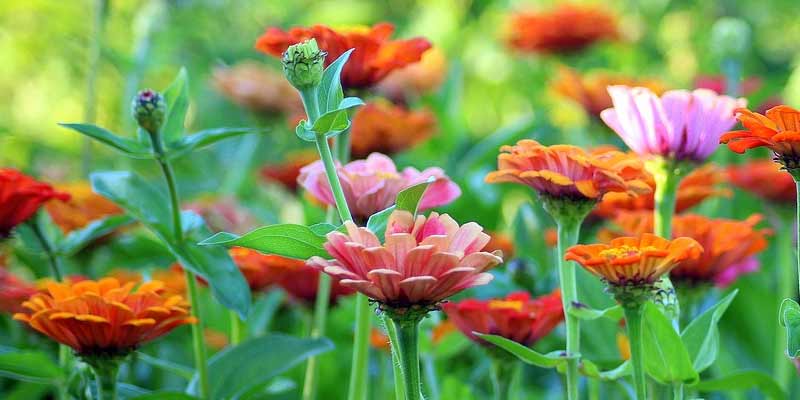A gardener finds delight in the vibrant hues and remarkable resilience of zinnias; these annual flowers thrive across diverse environments, infusing gardens, landscapes, and floral arrangements with a burst of life. Nevertheless – like all plants – they succumb to nature’s whims: frost is particularly formidable for Zinnias.
Freezing temperatures, which can damage or kill plants, characterize frost. This presents a substantial challenge to gardeners – especially those who cultivate frost-sensitive species such as zinnias. By comprehending the response of zinnias to this phenomenon and applying suitable measures; we can mitigate potential damage: thus ensuring that these beloved flowers continue their vibrancy.
Understanding Zinnias
Understanding the characteristics and growing habits of zinnias (Zinnia spp. ), which belong to the Asteraceae family and are primarily native to Mexico in the Americas, is essential before exploring their frost tolerance. Various shapes, sizes, and colors characterize them; their diversity offers versatility in landscaping, and they can be utilized for cut flower arrangements and pollinator gardens.
Warm-season annuals, such as zinnias, undergo their life cycle within a single growing season; they typically prosper in temperatures exceeding 50°F (10°C). The warmth to which they favor renders them vulnerable to frost damage when ambient conditions plummet below freezing point – usually around or lower than 32°F (0°C).
Frost and Its Effects on Zinnias
Primarily, the dual threat that frost presents to zinnias manifests through its impact on plant tissues and water content; when temperatures plummet, the water within plant cells freezes. This freezing process causes cellular damage, in which ice crystals form and subsequently rupture cell walls.
Moreover, this disruption of vital physiological processes can lead to wilting and discoloration–ultimately resulting in death of the plant.
Factors such as cultivar, growth stage, and environmental conditions determine the varying degrees of frost susceptibility that zinnias exhibit. Their tender growth and limited root systems make young seedlings and newly transplanted ones particularly vulnerable to frost.
While mature foliage on established plants with sturdy stems may withstand mild frosts for short durations, prolonged exposure to freezing temperatures can cause severe damage.
Assessing Frost Damage
To identify frost damage in zinnias, one needs a keen eye and an understanding of physiological responses to cold stress. The external symptoms of such damage might manifest as blackened or translucent patches on leaves and wilted foliage; furthermore, the plant may exhibit an overall lack of vigor.
Upon closer inspection, affected tissues could seem water-soaked, even mushy, suggesting cellular breakdown because of freezing.
Zinnias, though they may display remarkable resilience in challenging circumstances: severe frost damage could be irreversible. To prevent the spread of disease and foster overall garden health, a necessary course of action is the removal of affected plants.
6 Strategies for Protecting Zinnias from Frost
To safeguard zinnias from frost and extend their growing season, one must take proactive measures; these flowers are inherently susceptible:
1. Site Selection
Select planting locations: they must bask in ample sunlight and provide a degree of shelter from cold winds; avoid frost pockets at all costs. Opt for south-facing slopes as these offer natural warmth, bolstering your plants’ defenses against potential frost damage. Similarly beneficial are areas near buildings or hedges: these act as protective barriers further shielding your greenery from harmful chilling effects.
2. Timing of Planting
Ensure you coordinate your zinnia planting with the local frost dates; establish seedlings or transplants only after the threat of frost has dissipated. In regions characterized by short growing seasons, initiating indoor zinnia growth several weeks prior to the last recorded frost date can provide them a significant advantage, significantly enhancing their chances for successful outdoor acclimation.
3. Mulching
Insulate the soil and regulate temperature fluctuations by applying a layer of organic mulch around zinnia plants. The retention of soil moisture, moderation in soil temperature, and minimization of frost penetration all occur due to mulch; this provides an effective protective buffer for zinnia roots during periods marked by cold spells.
4. Covering Plants
Forecasting frost is an action that necessitates protective measures for zinnia plants. To create a microclimate, one conducive to plant survival, trap heat by covering this delicate flora with either lightweight fabric or floating row covers.
However, take care in securing the coverings; they should be loose enough to prevent foliage damage and yet permit essential air circulation. The objective is shielding your plants from direct exposure—this will safeguard them against potentially damaging freezing temperatures.
5. Watering Practices
Promoting cellular hydration and reducing susceptibility to desiccation, adequate soil moisture enhances zinnias’ ability to withstand frost. Nonetheless, overwatering zinnias proves detrimental; it exacerbates cold stress—predisposing plants to root rot and other moisture-related ailments.
6. Pruning and Cleanup
Promptly remove any damaged or frost-killed foliage from zinnia plants; this action prevents disease spread and fosters new growth. During recovery, pruning promotes overall plant vigor by directing resource allocation toward healthy tissues.
Conclusion
In conclusion, zinnias despite their remarkable resilience and adaptability – remain vulnerable to frost’s detrimental effects; this indicates that immunity is not a characteristic they possess in the face of such conditions. To guarantee health and longevity within your garden, it becomes crucial to understand these plants’ tolerance towards frost as well as implement proactive protection strategies.
Gardeners can enhance the zinnias’ ability to withstand frost and prolong their radiant beauty throughout the growing season by leveraging site selection; timing of planting; mulching, covering plants with a focus on optimizing watering practices, and implementing diligent pruning and cleanup.
Gardeners must ultimately combine knowledge, preparation, and attentive care to successfully cultivate zinnias in frost-prone regions; this allows the beloved flowers to thrive against nature’s ever-changing conditions. By planning properly – vigilantly nurturing their blooms through icy nights – they can then revel in a reward: resplendent blossoms greeting them on warmer days’ return.



Leave a Reply